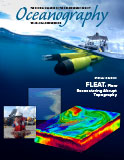Article Abstract
Mixing in the Samoan Passage has implications for the abyssal water properties of the entire North Pacific—nearly 20% of the global ocean’s volume. Dense bottom water formed near Antarctica encounters the passage—a gap in a ridge extending from north of Samoa eastward across the Pacific at around 10°S—and forms an energetic cascade much like a river flowing through a canyon. The 2011–2014 Samoan Passage Abyssal Mixing Experiment explored the importance of topography to the dense water flow on a wide range of scales, including (1) constraints on transport due to the overall passage shape and the heights of its multiple sills, (2) rapid changes in water properties along particular pathways at localized mixing hotspots where there is extreme topographic roughness and/or downslope flow acceleration, and (3) diversion and disturbance of flow pathways and density surfaces by small-scale seamounts and ridges. The net result is a complex but fairly steady picture of interconnected pathways with a limited number of intense mixing locations that determine the net water mass transformation. The implication of this set of circumstances is that the dominant features of Samoan Passage flow and mixing (and their responses to variations in incoming or background properties) can be described by the dynamics of a single layer of dense water flowing beneath a less-dense one, combined with mixing and transformation that is determined by the small-scale topography encountered along flow pathways.

